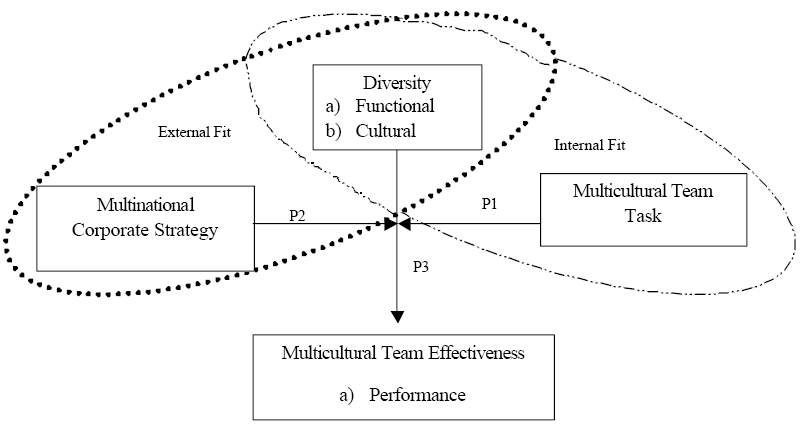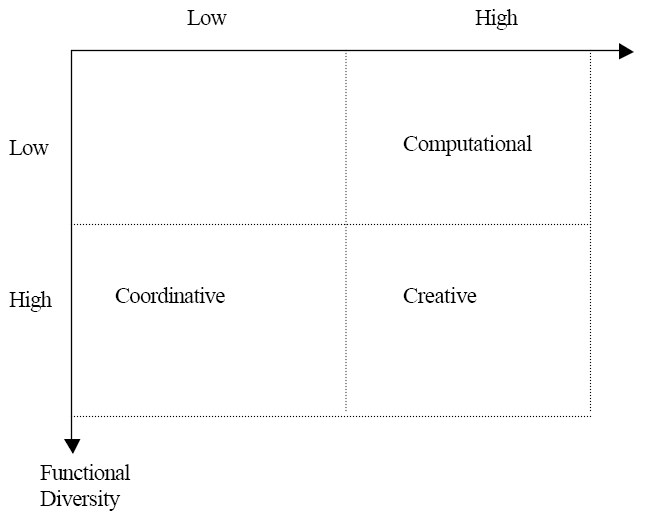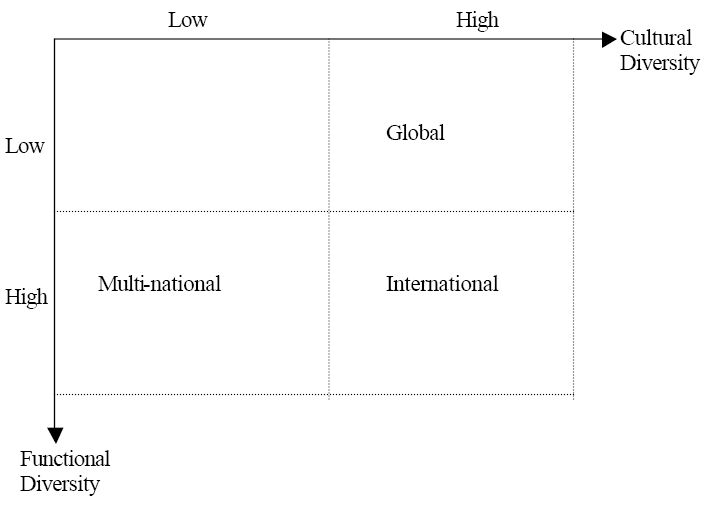Introduction
The purpose of this paper is to investigate the diverse approaches to managing the cross-cultural issues among the operation of MNCs and to identifying how successfully they are managing ethically to gain organisational objectives while the paper also aimed to evaluate the effectiveness of the process of their Managing Diversity.
Due to global nature of operation, MNCs have to gather people from different ethnic and cultural setting under a single umbrella where the enlargement of superior cross- cultural appreciation has turned out to be an indispensable component of MNC’s operation.
This paper has been deliberated with the theoretical framework managing diversity under a cross-cultural environment of MNCs, their critical analysis with imperial evidence from Pfizer, and to draw recommendations to managing ethically the cultural differences and conclusion.
Literature of Cross Cultural Issues
Tahir and Ismail (2007) pointed out that the cross-cultural diversity management is a process where the management would be interested acquire into account of cultural differences as well as capabilities to become accustomed to the different cultures.
The Culture is the foundation of a society that assists to build up the attitude and state of mind of the populace of that society and it also directs the intelligence and manipulate the behaviour of the individuals and their perceptions functioning politically drives to prioritise decisions making process and show the rote to collective thinking with their lives.
Cultural heritage has been rooted in such a way where individual could not break up self-awareness s well as cultural awareness from where he comes from. Every individual of a certain culture has to go ahead with clear understanding of his culture with the intention of carrying out enhanced awareness and how culture persuaded his private lives.
Takeuchi and Duriau (2000) explained that due to global business operation the MNCs have identified four types of orientations and most of the modern business organisations that are in international operation has engaged to choose and practice them.
The HRM managers of the MNCs now a day have the propensity to pledge to these significant management orientations with the aim to produce competitive advantages in their international operations emphasising on the organisational objectives and the pointed orientations are as below-
The Ethnocentric Orientation
Prasad, et al, (1997) mentioned that this types of course of action can be identified as the ‘country of origin or home country oriented’ where the headquarter situated and the top executives may emphasis to the postulations that policies and practices those are functioning in the head office as well as home country, the subsidiaries and branches must follow elsewhere.
The Polycentric orientation
Griffin (2006) defined that the orientation when turned toward the ‘host-country oriented’ that top executives consider that essentially some parts of the company has situated in the particular host country and such entry have to be staffed from local populaces for most of the possible coverage of employees.
The Regiocentric Orientation
Griffin (2006) suggested that the region oriented is the method of global management move towards the local involvement where the top ex executives supposed to take into consideration that the geographic localities have the team spirit that make a regional focus and advantageous. Individuals from those areas are generally most excellent get to the bottom of the MNCs dilemmas are problems related to that region.
The Geocentric orientation
Takeuchi and Duriau (2000) explored that this category of orientation associated with the ‘world-oriented’ managing diversity where the top executives implicate the vision of global trend essential for both in the head office of the mother company. Prasad, et al, (1997) added that the company and its assortment of subsidiaries would argue that the excellent employees should be appointed from the host countries.
Kirton and Greene (2005) explored that by make out the categories of orientation-practiced policy and practice of the company will lend a hand to verdict on the stage of errands and detailed roles would contribute the companies to managing the cross cultural diversity of MNCs.
Managing Diversity of Cross Cultural Issues
Mejia, Balkin and Cardy (2006) mentioned that the diversity simply refers to human characteristics that make people different from one another and managing diversity indicates the process by which the organisations bring them under a single umbrella.
There are many different cross-cultural backgrounds those are imperative in the organisational and that people from different ethic backgrounds can coexist and flourish their potentiality within the organisation. Usually diversification refers to cross-cultural factors such as ethnicity, race gender, physical ability and sexual orientation, but sometimes age and other factors are added. Stoner, Freeman and Gilbert (2006) argued that the belief that people from different cross-cultural backgrounds can work together is fundamental to democracy and the way of organisational life.
Steiner and Woods (2007) argued that in order to address the necessary to discuss the dilemmas from the perspective of a Human Resources manager working with staff about to take on international assignments within a large, multi-national company is the managerial challenge is learning how to take advantage of this diversity management while fostering cooperation among dissimilar employees is essential to bring competitive advantage for the organisation.
The HR department may help to meet the challenge by developing training programs, offering assistance and advice, establishing fair selection procedures and managing workforce diversity is the way in both respects that the employee promotes a shared sense of corporate identity and vision is one of the greatest challenge facing organisations today (Prasad, et al., 1997).
Cross-Cultural Challenges
Tahir and Ismail (2007) identified that the MNCs has to face tremendous challenges with the cross cultural issues during their global operation-
- Attitude of the Host Country: Deresky (2008) pointed out that some time it is difficult for the MNCs to exactly understanding the roundabout and non-confrontational behaviour of the host county
- Custom and Religion: It is also challenge for the MNCs to realize the core values of the custom and religion of any country as there may exist several multi cultural customs and ethnic groups and minorities (Luthans and Davis, 2004);
- Carefulness with Religious Issues:- As the religion is a sensitive issue for the petulance, MNCs needed to over conscious to handle with such issues and associated believes,
- Assessing Social Status: – Before opening a venture in any new destiny, MNCs take assessment with the host counties social structure and status, but there is always complexity to appropriately addressing host country’s social values, structure, and courtesies for easygoing interaction (Hill, 2009);
- Gender Issues Expose: – Gomez-Mejia, Balkin and Cardy (2006) pointed out that the most imperative dimension of diversity in MNC is gender diversity while the workforce is rapidly moving from being male-dominated to one of equality in numbers between men and women. Nevertheless there remain many barriers for women seeking equal treatment in most MNCs while there are more women in the workforce than ever before; they are still largely in junior positions (Friedman, 2002);
- Recruitment challenges: – According to the view of Morrison (2002), most MNCs lead their recruitment policy with ‘higher talents and higher pay’ dimension but due to identifying proper talents, the recruitments face incredible challenge to ensure effectual service to fit the organisational objectives,
- Cross-cultural Training: – It is essential for the MNCs to come into operation in a new destiny, obviously introduce a well thought-out Cross-Cultural Training for the both management and employees including orientation program and it turns into a challenge to take into practice for the MNCs in host countries.(White and Fan, 2006)
Multicultural Team Effectiveness
Prasad, el al, (1997) argued that MNC’s tragedy model of formatting multicultural team efficiency has represented in Figure – 1, where the basic characteristics of the model highlights two dissimilar kinds of contingencies and these are external fit among MNC’s strategic planning and team diversity and internal fit among team work and group diversity.
According to the team essence the affiliation among MNC’s strategy and diversity an external issue that is outside the team context and the connection among task and diversity would be internal for the reason that task fit in to the team essence (Kesler and Law, 1997).

DeCenzo and Robbins (2007) also added that within the Contingency model of Diversity, each elements of the model has been explained in the first segment and simultaneously the conception of fit has been functional to multicultural teams has residential and discuss for detailed types of task as well as MNC strategy.
The propositions of Contingency model of Diversity have been recapitulated in Figure 2 & 3, as a final point, the contingency model has been incorporated within the last segment and amalgamated.

MNC Team Diversity
Stoner, et al, (2006) pointed out that the demographic heterogeneity within organisational performance is also as a determinant for team effectiveness and it has been objected to growing intellectual attention when firms are conflicted in front with more and more diversity in workforce. In adding together, strategy experts have checked up the work of art of top management teams as well as their consequence on strategic leadership.
The Top Management Team (TMT) literature provides various demographically unpredictable issues have been considered together with age, tenure, gender, functional conditions as well as race and education. On the other hand, the consequences of this study regarding the effect of diversity on team performance are ambiguous (Morrison, 2002).

Critical Analysis: Multiculturalism and Organisational Success
Gomez-Mejia, et al, (2006) explained that most organisations in the international operation have realised that diversity exists and that the culture of any organisations must pay attention to the needs of a set of very diverse employees. In short, many managers are grappling with how to make their corporate culture more in tune with the issues of cross cultural issues.
Griffin (2006) explicated that the cost argument demonstrates that if organisations keep very poor efforts to managing diversity issues due to the involvement of higher costs but the conflicting cross cultural scenario brings poor performance syndrome with expensive while women and minorities leave the organisation and never return on the investment it has made in them.
In addition, if the cross cultural issues aren’t managed well, and then individuals may not be comfortable as they could be in the work environment and they spend time and energy worrying about discrimination, harassment, and other issues rather than their jobs (Prasad, et al., 1997).
Luthans and Davis (2004) agreed that the resources acquisition argument demonstrates that companies who handle cross cultural issues well will have an advantage over other companies in hiring multicultural workers an increasingly important advantage in this competing business environment.
Mejia et al (2006) indicated that the creativity and the problem solving arguments demonstrates that groups of people from diverse backgrounds can be more creative than groups with homogeneous backgrounds, and are better at solving problems however steps must be taken to realize these benefits In a particular team members must become aware of possible attitude differences in others and there must be a core of share benefits or shared values around which people can expense their differences.
For instance, Boujema, et al, (2005) mentioned that Pfizer is a Multinational pharmaceutical company with home county of USA but operating in over 60 countries with 122,000 employees outside of USA. Pfizer has become one of the benchmark companies by successfully managing diversity of cross cultural issues through amalgamation of racial and gender diversity with advanced thought and strapping perspective.
Pfizer emphasised on essentiality of global employees’ value proposal with clear indication of key rewards for the employees, value exalting competitive compensation, lucrative benefit packages including cross cultural training to enhance commitment and common language.
Thus the HR department of Pfizer has effectually managing diversity of cross cultural issues and keeping continuous efforts to remove differences within the employees that will generate competitive advantage for the organisation.
Finally, the system flexible arguments say that the ability to manage diversity increases the adaptability and flexibility of an organisation with external and internal issues can be responded to more quickly and to manage diversity successfully, an organisation must question outdated policies and procedures that emerged in days when cross culture was not a large concern for the organisations.
Recommendations
It has been prescribed for the firms those follow a multinational strategy, are aimed to respond complying with local market conditions as major objective where every national associates or overseas subsidiaries are given enormous autonomy and administer as a self-governing business unit.
In this context, organisations pursue a global strategy faced on world markets. They impose their highest importance on global efficiency accumulating from the scale and scope of economies. In the concluding point, organisations pursue an international strategy on emphasising knowledge and know-how in overseas affiliates.
It is also suggested that MNCs are required to reduce more dependency and attachment of corporate headquarters as well as market expansion and they are further treated as while affiliates are needed allowed to adapt business strategies as well as products depending on the requirements of local market within the area of its operate. Positively they are fully dependent on the mother company concerning process innovation, new product development and selecting market strategies.
MNCs adopt efficient conditions and national cultural ideology for team diversity while the team farm duties within MNC strategy have two important unforeseen events in an MNC background and investigating the dependent relationships that may survive for multicultural teams all along these scopes emerge to be important.
There are numerous dissimilar types of multicultural teams, such as a project team increasing a product suitable for multiple countries, a business team accountable to put together and put into practice global strategies. The task force is in incriminating for trim down worldwide manufacturing, while many multicultural groups are shaped for the time being for specific purposes. They also do not have to be project-based or time-bound
Conclusion
Successful organisations and MNCs believe that the strong, faithful cross cultural employees construct businesses competitive are an intramural part of Diversity Management and the smartest organisations realise that the employer play an essential role in creating their employees strong and faithful. Thus, the knowledge goes quick to listen and slow to speak is imperative and understanding to diversity management of cross cultural employees.
MNCs always try to gain the trust of their employees with full emphasize on their motivation, training and interaction to development of their employees and at the same time employees go to the workplace with prospects and expectation of working with the managers who are good virtues like personal treatment, professionalism, working support respect and trust. Thus, managing diversity of cross-cultural issues and significantly weigh up the cross-cultural factors at internal and external fits of the multinational corporation is a benchmarking approach.
Reference List
Boujema, K. et al., (2005) A Cross-Cultural Perspective On Managing Diversity. Web.
DeCenzo, A. D. & Robbins, S. P. (2007) Management. 8th ed. Singapore: John Wiley & Sons, Inc.
Deresky, H. (2008) International Management: Managing Across Borders and Cultures. 6th ed. London: Pearson Prentice.
Friedman, T. (2002) The Lexus and the Olive Tree. 1st ed. London: Harper Collins Publishers.
Gomez-Mejia, L. R., Balkin, B. D., and Cardy, L. R. (2006) Managing Human Resource. 4th ed. New Delhi: Prentice Hall of India.
Griffin, R. W. (2006) Management. 8th ed. New York: Houghton Mifflin Company.
Hill, C. (2009) International Business: Competing in the global marketplace. 7th ed. NY: McGraw- Hill Irwin.
Kirton, G. & Greene, A.M. (2005) The Dynamics of Managing Diversity: A Critical Approach. 1st ed. London: Butterworth Heinemann.
Luthans, F. & Davis, K. (2004) Human Resource, and Personal Management. 5th ed. London: McGraw Hill.
Mejia, L. R. G., Balkin, D. B. & Cardy, R. L. (2006) Managing Human Resources. 4th ed. New Delhi: Prentice-Hall.
Morrison, J. (2002) The International Business Environment: Diversity and the global economy. London: Palgrave Macmillan.
Prasad, P., et al., (1997) Managing the Organisational Melting Pot: Dilemmas of Workplace Diversity. 1st ed. London: Sage Publications.
Steiner, J. & Woods, L. (2007) EU Law. 9th ed. London: Oxford University Press.
Stoner, J. A. F., Freeman, R. E., & Gilbert, D. R. (2006) Management. 6th ed. Delhi: Prentice-Hall of India Private Limited.
Tahir, A.H.M & Ismail, M. (2007) Cross-Cultural Challenges and Adjustments of Expatriates: A Case Study in Malaysia. Alternatives: Turkish Journal of International Relations, 6(3). Web.
Takeuchi, R. & Duriau, V. J. (2000) Internal and External Fit of Multicultural Teams Within Multinational Corporations. The Academy of International Business. Web.
White, C., & Fan, M. (2006) Risk and Foreign Direct Investment. London: Palgrave Macmillan.